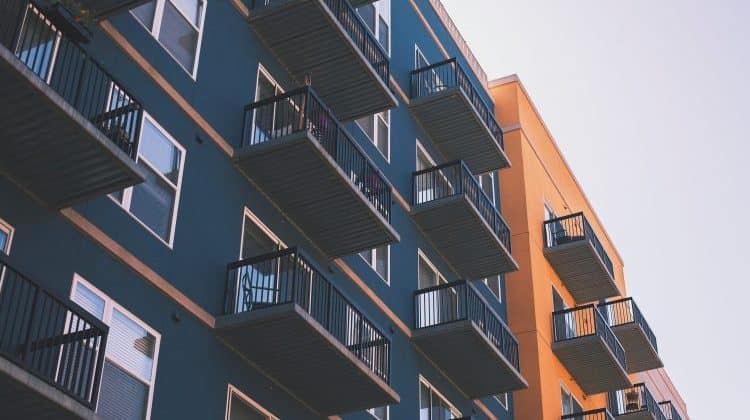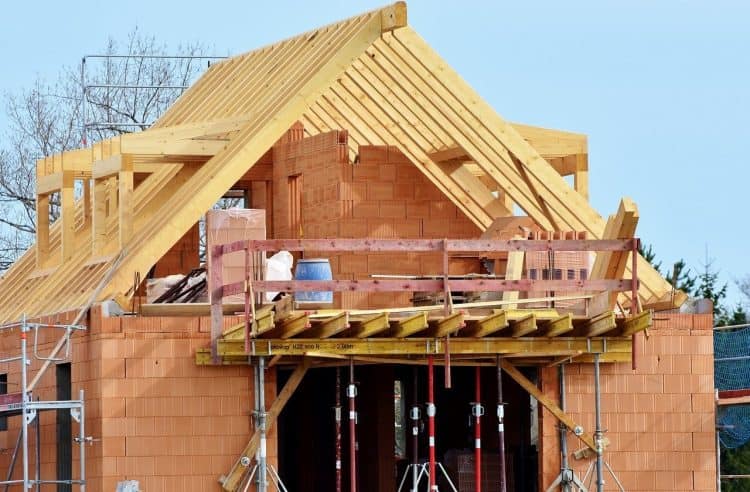
Looking for a one-stop shop to all of the basic real estate investing calculations you’ll ever need? Then you’re in the right place!
The math behind real estate investment calculations is really pretty simple. But sometimes the acronyms and jargon can get in the way (NOI, ROI, IRR, GRM…it’s enough to make your head spin)
Don’t worry, we’ll cut through all the clutter and simplify all the numbers you’ll need to know. These are the calculations I use in my own real estate investing whenever I am looking to buy, sell, or even figure out whether to keep holding a property.
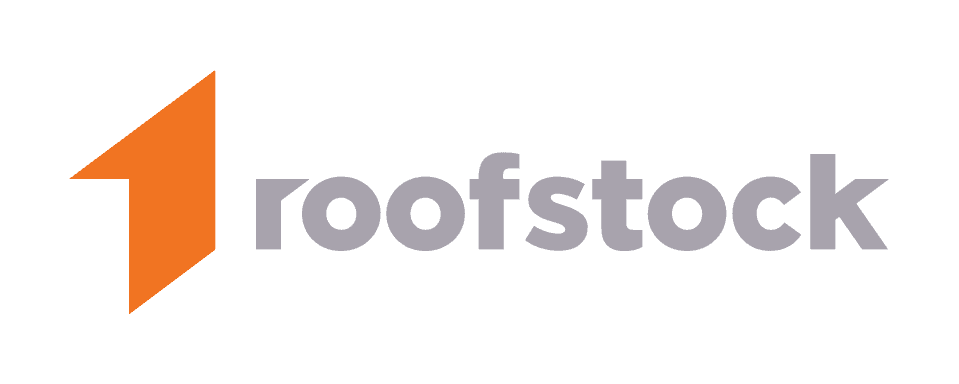
Wealthy Nickel Note: If you’re in the process of looking for your first (or next) rental property, check out Roofstock. They are the only online marketplace I know of that focuses specifically on selling single family rental properties to investors. Sign up for a free account, and if nothing else, you can use their listings to practice your real estate investing calculations!
12 Real Estate Investing Calculations You Need to Know
1. Net Operating Income (NOI)
NOI = Operating Income – Operating Expenses
Net Operating Income (NOI) is the income left after accounting for your operating expenses and BEFORE debt service. Net operating income is one of the most important numbers you should know, because it’s also used in so many other calculations (such as cap rate, debt coverage ration, etc.)
NOI take into account your gross income, vacancy loss, and operating expenses such as maintenance, repairs, taxes, insurance, and property management. Basically all expenses except for the principal and interest on your mortgage payment and capital expenses. NOI is what you have left at the end of the day to pay your lender – and therefore your lender finds this number extremely interesting.
Net Operating Income Example:
Let’s say you have a property that rents for $1,500 per month and we assume an 8% vacancy loss ($120). The property also has the following expenses:
- Repairs/maintenance – $150
- Property management (10%) – $150
- Property taxes – $200
- Insurance – $75
- Total expenses – $575
So your operating income is $1,380 ($1,500 – vacancy loss of $120), and your operating expenses are $695. That leaves you with an NOI of $805 ($1,380 – $575) per month, or $9,660 per year. Remember, this doesn’t account for your debt payments, but if you own the property free and clear, this is the amount that would go into your pocket.
2. Capitalization Rate (Cap Rate)
Cap Rate = NOI / Purchase Price
The Capitalization Rate (or “Cap Rate” for short) can be used as a simple calculation to compare similar properties. It essentially tells you the rate of return of a property if you bought it for cash. Since debt terms and amounts can often vary deal by deal, using the cap rate is a way to eliminate debt as a variable and compare the returns on a property as if you were paying all cash.
Cap rates are mostly used in the commercial real estate world, and cap rate data is collected for various product types (office, multifamily, industrial, etc.). Usually the riskier the asset, the higher the cap rate. So if you are comparing 2 multifamily properties, one that was built a few years ago in a hot area of town, and the other that was built 30 years ago in a Class B or C neighborhood, you would expect the latter property to have a higher cap rate.
To understand this, you can look at the equation (Cap Rate = NOI / Purchase Price). Assuming the 2 properties have the exact same NOI (net operating income), the lower the purchase price, the higher the cap rate.
In a vacuum, the cap rate is somewhat of a meaningless number. But when you know what cap rates other similar properties sold for, you can get an idea for what the market value of a property might be. Cap rates vary by asset type, asset class, geography, and many other variables. For example, a Class B multifamily in Cleveland, OH might trade at a 7% cap rate, whereas the same property in San Francisco might sell at a 4% cap rate.
Cap Rate Example:
Let’s compare the cap rates of 2 different properties in the same city. Suppose both of these properties had the same NOI of $1M per year. One property is brand new with the latest amenities in the best part of town. The other property is older and a little outdated, but in a decent neighborhood.
If the brand new property with fancy amenities is priced at $25M, it would have a cap rate of $1M / $25M = 4%.
And if the older property had a market value of $16M, it would have a cap rate of 6.25%.
This example shows that a higher cap rate denotes a lower sales price for the same amount of income, based on desirability and risk of the property.
3. Rent to Cost Ratio
Rent to Cost Ratio = Monthly Rent / Total Property Cost
The Rent to Cost Ratio is another quick way to compare similar properties to each other. I use this all the time as a quick check to screen out properties I am considering buying, before I do a deeper dive into the financials.
This metrics gives you the monthly rent as a percentage of total property cost (purchase price plus any repairs needed to get it rent-ready). This is the ratio that is used for the popular 1% rule, which states that (in general) the rent to cost ratio should be at least 1% in order to cash flow as a rental property.
I have an entire article on the 1% rule and how to apply it. I think this is one of the most important concepts to learn as a new investor.
Rent to Cost Ratio Example:
Consider a property you are thinking of buying for $120,000 that needs $10,000 of work to get it ready to rent out at $1,500 per month. The rent to cost ratio would be:
Monthly Rent / Total Property Cost = $1,500 / ($120,000 + $10,000) = 1.15%
Based on the 1% rule, this is likely a good cash-flowing property (since the ratio is greater than 1%). You would want to do a deeper dive on the actual operating expenses and rehab costs needed, but the rent to cost ratio provides a quick and easy number to compare to other potential rental properties.
FURTHER READING: How to Use the 1% Rule To Quickly Evaluate Rental Properties
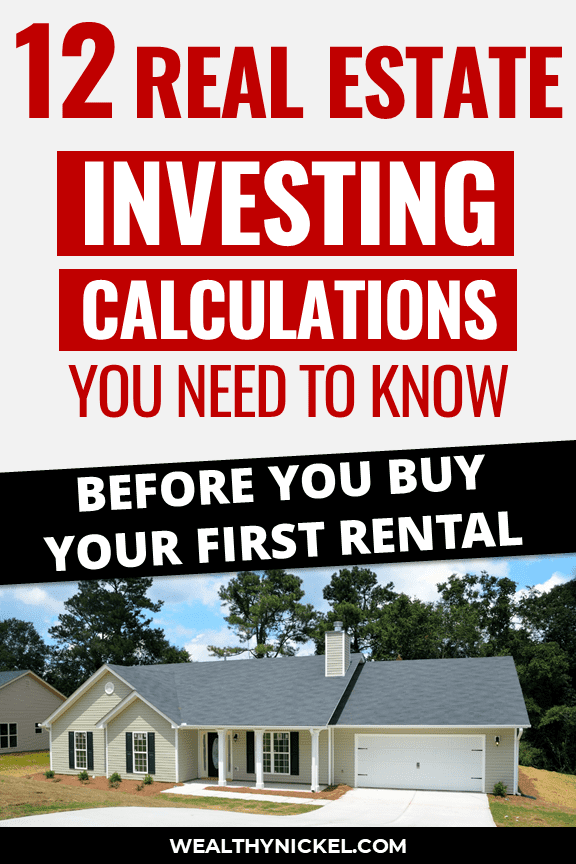
4. Gross Rental Multiplier (GRM)
GRM = Total Property Cost / Gross Annual Rent
The Gross Rent Multiplier (GRM) is another way of looking at the rent to cost ratio, and basically gives you the same information in a different format (an annualized number that is the inverse of rent to cost). I find the Rent to Cost Ratio to be more intuitive, but often times an advertisement might list the GRM and not the rent to cost ratio, so you want to be familiar with what it means.
The GRM is the total property cost (purchase price plus repairs needed) divided by the expected gross annual rents.
GRM Example:
Let’s use the same property as our example for Rent to Cost ratio ($120,000 purchase price, $10,000 in repairs to make rent-ready, and expected monthly rent of $1,500). The calculation would be:
GRM = Total Property Cost / Annual Rent = ($120,000 + $10,000) / ($1,500 * 12) = 7.2
This shows that the total property costs are 7.2X the annual rents. And since we used the same numbers as our previous example, a Rent to Cost Ratio of 1.15% is equivalent to a GRM of 7.2.
Note that if you are following the 1% rule as a quick screen, then that would be equivalent to a GRM of 8.33. With GRM, lower is better. So if you are using GRM to screen out properties that don’t meet the 1% rule, you’d want to only look at properties that had a GRM of 8.33 and below.
5. Debt Service Coverage Ratio (DSCR)
DSCR = Net Operating Income / Debt Service
The Debt Service Coverage Ratio (DSCR), or sometimes referred to as Debt Coverage Ratio (DCR) is a metric many lenders use to determine whether a property has enough income to cover the loan. DSCR is calculated by taking our friend, Net Operating Income (NOI) and dividing by the debt service (principal plus interest).
Most lenders want to see a DSCR of at least 1.2, which means that the property is generating enough to pay the debt plus an additional cushion of 20%.
DSCR Example:
If you own a multifamily property that generates $100,000 in NOI monthly, and your payments to the lender are $80,000 per month, then your DSCR would be:
NOI / Debt Service = $100,000 / $80,000 = 1.25
This means that you are generating 25% more cash flow than it costs to pay the loan. This cushion helps protect the lender should things go south (higher vacancy, lower rents, etc.), and is also the amount that goes in your pocket as the owner after paying the lender.
6. Break-Even Ratio
Break-Even Ratio = (Operating Expenses + Debt Service) / Gross Income
The Break-Even Ratio is another way to look at how a property is performing in relation to the debt payments. It is similar to the DSCR, but answers a slightly different question – what percentage of the gross income do your total expenses account for? This metric can be used to easily see how much gross income can fall and still stay cash flow positive.
Break-Even Ratio Example:
Consider the same multifamily property in the DSCR example above. This time, we need the Operating Expenses (not to be confused with NOI) and Gross Income numbers. If Gross Income is $200,000 and Operating Expenses are $100,000, and the debt service remains the same at $80,000, you can calculate the Break-Even Ratio as:
(Operating Expenses + Debt Service) / Gross Income = ($100,000 + $80,000) / $200,000 = 0.9 or 90%
This says that the total expenses amount to 90% of the gross income. So if, for example, you had a 10% vacancy rate and your gross income dropped, you would be at the Break-Even Ratio (zero cash flow). This might be a marginal deal, because in a downturn, you could easily hit 10% vacancy or even higher, and not be able to make your debt payments.
7. Cash on Cash Return
Cash on Cash Return = Cash Flow Before Taxes / Cash Invested
The Cash on Cash Return is another metric I watch closely for my own rental properties. It gives you your annual cash return as a percentage of your total cash invested.
I like to make sure that any property I buy will give me at least a 10% cash on cash return after accounting for all expenses. This one is easiest to explain with an example.
Cash on Cash Return Example:
Suppose you are analyzing a new single family rental house to add to your portfolio. You can calculate your total cash flow (before taxes) by taking your NOI and subtracting debt service.
Let’s say the property is for sale for $150,000, and my expected NOI is $15,000 per year. I also want to get a loan for 70% of the purchase price (putting down $45,000). If the debt service is $10,000 per year, here is the calculation of cash on cash return:
Cash Flow Before Taxes / Cash Invested = (NOI – Debt Service) / Cash Invested = ($15,000 – $10,000) / $45,000 = 11.1%
That means that your actual cash return (what goes into your bank account) is 11.1% of your initial investment per year. Another way of looking at it, is it will take 9 years to make back 100% of your initial investment (100% / 11.1%).
While there are a lot of other benefits to owning real estate (such as appreciation, favorable tax treatment, and mortgage paydown), making sure you are cash flow positive is one of the most important things you can do to protect yourself in a downturn. That way, even if rents go down or vacancy goes up, you have some cushion to protect you and you won’t be taking cash out of your own pocket to pay the bills for your investment.
8. Price Per Square Foot (PSF)
Price Per Square Foot = (Sales Price or Rent Price) / Total Square Footage
Price Per Square Foot is another easy metric to compare similar properties, whether you are looking at the purchase price or rents they generate. It’s a simple calculation to understand – just take the sale price (or rent price) and divide by the square footage of the property.
If you know that in your area, a good rental generally sells for $100 per square foot, you can compare that to the asking price of a property to determine if it’s worth a further look.
Similarly, you can use this metric to get a rent price per square foot and compare it to other properties.
PSF Example:
Let’s say you are looking at 2 similar properties. One is a 1,000 square foot house that rents for $1,000 per month and is for sale for $100,000. The other is a 1,500 square foot house that rents for $1,300 per month and is for sale for $150,000.
Both have a sales price per square foot of $100 ($100,000 / 1,000 sf and $15,000 / 1,500 sf). But the smaller house has a rent price per square foot of $1 ($1,000 sf / $1,000), and the larger house has is $0.87/sf ($1,300 / 1,500 sf). All else being equal, the property that rents for more per square foot would provide more cash flow as a percentage of the amount you have invested.
9. 50% Rule
Total Expenses = 50% x Gross Income
The 50% Rule isn’t so much a metric as a general rule of thumb. Like the 1% rule, it’s an approximation that is useful for quick and dirty analysis before you spend too much time digging into the detailed financials.
The 50% rule says that, in general, you can expect the total expenses of a property (not including debt service) to equal 50% of your gross income.
50% Rule Example:
If you have a house that rents for $1,500, you can expect to pay about $750 (50% of $1,500) on all your expenses such as property management, taxes, insurance, repairs, vacancy, and capital expenses. That leaves you $750 to pay the principal and interest on the loan, and any cash left over is your profit.
I will stress again that this is a rule of thumb for quickly comparing similar properties. Once you’ve narrowed it down to a specific property, make sure you plug in real numbers for all your expenses (i.e. look up actual taxes from the appraisal district, get an insurance quote, etc.) But I will say that in my experience it tends to be pretty accurate overall, plus or minus 5-10%.
10. 70% Rule
Max Purchase Price = 70% of After Repaired Value – Rehab
The 70% Rule is another rule of thumb, specifically for investors looking to flip houses. It says that the maximum amount you should pay for a house is 70% of the after repaired value (ARV) minus the rehab costs. That 30% should cover all of your costs (buying and selling costs, financing costs, holding costs, etc.) and still give you room for profit.
In my experience, actually finding houses that meet the 70% rule is extremely difficult given the hot real estate market we live in today. Something closer to the 80% rule is more doable. It all comes down to your own numbers and real costs whether you can make a profit at 70%, 80%, or even 85%. For my own rentals, I like to buy houses that need a lot of work and therefore get a discount for taking on the risk and extra work. I aim to buy them at a 20% discount (so the 80% Rule), though in some cases I will go higher.
70% Rule Example:
Here’s a real example of a property I bought as a rental. It needed A TON of work, and I therefore got a great deal. I paid $35,000 for it and ended up putting in about $50,000 in rehab. It needed everything – new roof, HVAC, flooring, bathrooms, kitchen, foundation work, etc. Once the rehab was complete, I refinanced into a conventional loan, and it appraised for $120,000. I was able to get a loan for 70% of appraised value ($90,000). Since I was all in to the property for $85,000 ($35,000 + $50,000), I was able to walk about with $5,000 in my pocket and a cash-flowing rental property!
Per the 70% Rule, I should have paid 70% x $120,000 – $50,000 = $34,000. So I was really close to that number. All in all, I was able to add a rental property to my portfolio AND increase my net worth by $35,000 ($120,000 appraised value – $85,000 purchase and rehab). Not a bad deal!
FURTHER READING: How to Invest in Real Estate With No Money (Is it Possible?)
11. Return on Equity (ROE)
ROE = Annual Return / Total Equity
Return on Equity (ROE) is a measure of the total return of your real estate investment (not just cash flow) divided by your total equity (how much you would put in your pocket if you sold today).
I measure my properties by this metric every year and make a determination on whether to continue to hold them or look for an opportunity to sell and deploy my cash elsewhere. If they aren’t pulling their weight (giving me my desired return on equity), it might be time to find a new investment.
One benefit of ROE is that you can compare the total return you’re getting on your rental property vs. the stock market or some other investment. When we say that the S&P 500 returned 7%, you are essentially saying that the underlying equity (value of shares in the S&P 500) went up by 7%. If you run the numbers on your rental property and discover your ROE is 3%, it might make sense to rethink why you are investing in that property instead of something completely passive like the stock market (diversification aside).
While the formula is deceptively simple, there are a lot of inputs that go into calculating ROE.
The annual return consists of the following components:
- cash flow
- appreciation
- mortgage principal paydown
In addition, your total equity is the current value of the property minus any outstanding mortgage balance.
So to restate, ROE = (Annual Cash Flow + Appreciation + Principal Paydown) / (Market Value – Mortgage Balance).
ROE Example:
Let’s say I have a $100,000 property I bought last year with a $70,000. My annual cash flow last year was $3,000, and it appreciated by 4% ($4,000). In addition, the principal balance was reduced by $1,000 thanks to paying the mortgage every month.
So when I purchased the property, I had $30,000 in equity ($100,000 purchase price – $70,000 mortgage). And I had a total return of $8,000 ($3,000 cash flow + $4,000 appreciation + $1,000 principal paydown).
That gives me a total ROE of $8,000 / $30,000 = 27%
Compared to the stock market (or any other investment) that is a pretty great return! What gets interesting is that the longer you hold the property, the more your equity increases, and therefore your ROE tends to go down over time. There are strategies to boost this, such as doing a cash out refinance on the mortgage, but sometimes if a property appreciates a significant amount but rents don’t increase at the same rate, it can cause your ROE to decline to the point where it may be wise to look at selling and investing somewhere else.
FURTHER READING: Return on Equity: The Secret to Real Estate Investing Success
12. Internal Rate of Return (IRR)
I am not even going to attempt to put the formula for IRR here. While the concept is relatively simple, the math behind it is not. There are plenty of tools out there that will calculate IRR for you, including my old favorite, Excel.
The Internal Rate of Return (IRR) basically evaluates the annual return of an investment, using a series of projected cash flows. For an investment property, you might have an initial negative cash flow for a down payment, then small positive annual cash flows while it’s rented out, then a large positive cash flow when it’s sold.
The IRR takes these cash flows and calculates the annual yield of the entire project from start to finish. It is very useful to compare multiple different projects. Generally you would want to pursue the one with the highest IRR.
I find IRR most useful when I am comparing crowdfunded real estate projects to one another. With crowdfunding, you are a passive player in the real estate game and what you really care about are the projected returns you will be getting over the life of the project.
Side Note: If you want to learn more about passive real estate crowdfunding, a few of my favorites for beginners are Fundrise and DiversyFund. You only need $500 to get started, and it lets you invest in a diversified portfolio of commercial real estate. I’ve found it’s an easy way to dip your toe in the RE investing waters, and learn as you go.
IRR Example:
If you bought a rental property with an initial down payment of $30,000, it returned $3,000 in cash flow each year for 4 years, and then on the 5th year you sold it at a profit and put $60,000 in your pocket, you can calculate the IRR of this chain of events using Excel. You have a series of annual cash flows:
- Year 0 = -$30,000
- Year 1 = +$3,000
- Year 2 = +$3,000
- Year 3 = +$3,000
- Year 4 = +$3,000
- Year 5 = +$60,000
- Total IRR = 22% (using Excel IRR() function)
Real Estate Investment Calculations – Wrapping Up
While there are a ton of other calculations you could learn in real estate investing, these are some of the best, especially for someone looking to get started in real estate investing. I use these 12 real estate investment calculations in my own investing, and they have served me well.
It’s important to realize that numbers can often be manipulated to show whatever you (or the seller) wants to show. So while the results these calculations produce are important, it is even more important to understand the underlying assumptions and what they mean.
Hopefully this article has helped you gain a better understanding of how to calculate some of the basic metrics you need to compare prospective rental properties and other real estate investments, and put you on your way toward success as a real estate investor!
One more thing before you go…
 If you’re in the process of looking for your first (or next) rental property, check out Roofstock!
If you’re in the process of looking for your first (or next) rental property, check out Roofstock!They are the only online marketplace I know of that focuses specifically on selling single family rental properties to investors. Sign up for a free account, and if nothing else, you can use their listings to practice your real estate investing calculations!
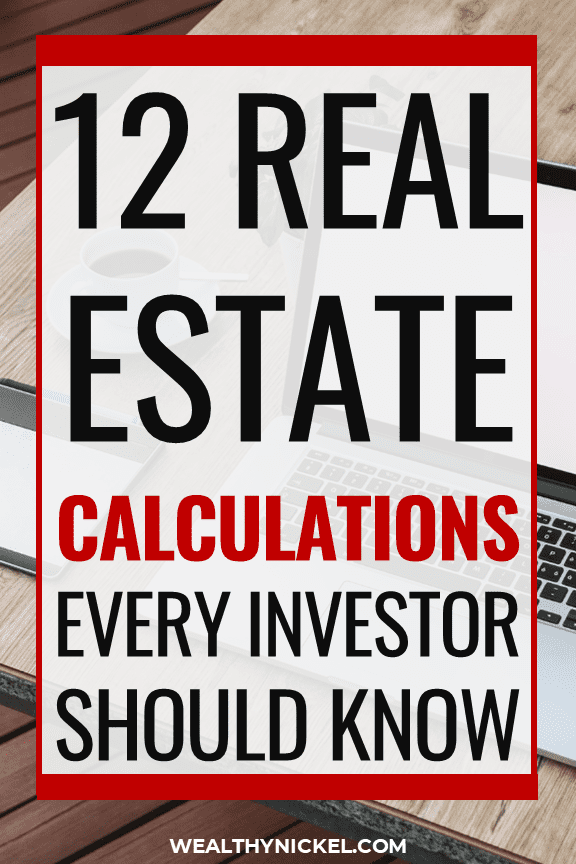
[ad_2]
Source link

